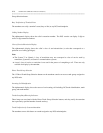
6-22 DISTRIBUTED COMMUNICATIONS SYSTEM (DCS)
_ ___________________________________________________________________________________________________________________________
_ ___________________________________________________________________________________________________________________________
_ ___________________________________________________________________________________________________________________________
Link m, channel n
Link i, channel j
DCIU or PI
Call goes over this
tie trunk.
C
B
A
Message for call
takes this route
All links and channels between
here used up , let’s say, so
take detour via B to find
a route to C.
DCIU or PI
DCIU or PI
Since some delay is introduced if the message takes a detour like this, however, the number of hops is not
unlimited. If too many hops are used to get the message to the destination, the last digit of the call will
arrive at the system at the other end of the trunk group and the call will be sent either to a station or on to
another node without the message data to make the call transparent. The number of hops the message can
take and still get to the terminating system on time depends on factors such as traffic and distance detoured.
A maximum of two hops is usually safe, but in some situations two hops might be too many. More than
two hops is not officially supported by AT&T.
DCS messages cannot traverse the AT&T Software-Defined Network (SDN).
In designing a DCS cluster that includes a System 75 R1V2 or System 75 XE R1V2 switch, remember that
these switches can serve only as endpoints in a DCS cluster, but not as tandem nodes. Because these
switches cannot tandem a DCS call from another node in the DCS cluster, in clusters consisting only of
System 75 (R1V2) or System 75 XE switches, a tie trunk group must interconnect every pair of nodes to
provide voice communications between all the switches.
Note that when a DCS cluster involves connections between a System 85, Generic 2, or DIMENSION and
another System 85, Generic 2, or DIMENSION PBXs, an economical alternative to incorporating two DSUs
in the DCIU connections is the 105A Isolating Data Interface (IDI). A 105A IDI provides ground isolation
for up to 400 feet cable distance between switch processors. It operates automatically with the synchronous
data speed selected for the DCIU. It also takes the timing from the DCIU as the controlling timing source.
There are no option settings on the 105A IDI.
In designing the intracluster routing for DCS with AAR (the PNA, UDP, or ETN [Standard Network]
package), it is recommended not to design the tie trunks with overflow to off-net facilities, since these
facilities do not support DCS. Because calls using public network facilities lose DCS transparency, the
inconsistency of feature operation between off-net and on-net calls may confuse users.


















